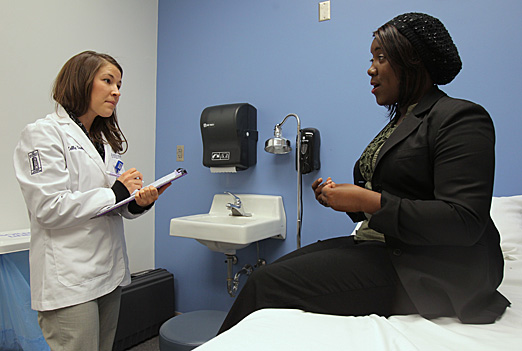“Mrs. Vasquez, the test results came back from the lab, and I’m afraid I have some bad news.”

Kelly Dooley, left, and Andrea Harris created a medical interview that provides a professional stretch for both.
At UT, physician assistant students have been finding those simulations intense, challenging — and a surprising amount of fun — thanks to an interdisciplinary collaboration between the College of Medicine and Life Sciences and the College of Visual and Performing Arts.
The result is a professional encounter between students of Dr. Vivian Moynihan, assistant professor of physician assistant studies, and those of Irene Alby, associate lecturer of theatre. The physician assistant students are enrolled in Moynihan’s Principles of Interviewing and Medical History class; the theatre students provide the syndromes, symptoms, concerns, questions and sometimes feisty opinions of the standardized patients.
“The theatre students’ participation have made the course almost entirely experiential, which a medical interviewing course needs to be,” Moynihan said. In a team approach, two physician assistant students conduct the interview, two others serve as peer evaluators; at the next interview, roles are reversed.
The most challenging interviews — those involving a patient’s sexual history, for instance, or ones conveying a negative medical outcome — are included.
“It’s a great way to practice such situations in a safe environment,” Moynihan said. “The teams didn’t know what the bad news would be until they walked in the door, then it was changed when the teams flipped. That allowed a wide range of emotions.
“The theatre students did not make it easy for the physician assistant students — and physician assistant students thought it was great.”
Physician assistant student Kelly Dooley recalled the unexpected realism when an actor played it angry: “I don’t know what came over me. I held it together during the interview, but afterwards I started crying because I was unprepared for that kind of emotion. It’s not you, it’s just that patients can be feeling bad, not in a great mood. It was awesome, working on communicating with them.”
From Alby’s perspective, the class is an opportunity for actors to hone their craft: “The use of standardized patients — and in other fields, mock trials and business simulations — are real ways that actors can find work.”
When Moynihan initially called with the idea, Alby said, the two immediately connected: “We decided we had to make it happen.”
The theatre students who participated in spring semester, she added, began by providing backstories for the medical scenarios Moynihan had created. “When you play a hostile patient, an actor wants to know the reason for the hostility,” Alby explained.
“Our goal was to be as honest as possible. Acting is always about reality, but there are different styles of acting — some with heightened reality, some that are funny. In this case, the students had to be absolutely real without any of the craft showing.
“Sometimes, real can be pretty extreme, but there had to be the sense each interview was reality, happening at that moment.”
Moynihan, who previously had relied on second-year physician assistant students to serve in the roles, praised both the increased realism and the intensity of the experience for both groups of students in the class, which will next be offered fall semester.
“The sense was that this was real,” she said. “The physician assistant students really valued the upperclassmen helping, but they’d act with an eye toward the medical technicalities. With the theatre students, it’s much more like a real patient interview.”
“You could see [the physician assistant students] nail something the second time that they’d missed the first time, or becoming more humanized rather than completely medical,” said Andrea Harris, a theatre/film major who participated. “And as actors, we were being challenged, growing in our characters. In one case, I had to find ways to portray pain I had never felt. There was a lot of improv in what we did.”
Alby, who has developed a theatre course devoted to standardized patient service, speaks for all actors when she exulted, “Finally, there’s an understanding that the type of skills we have are compatible with a field that on the surface seems so different.”